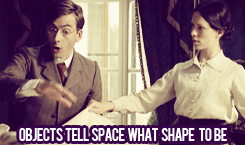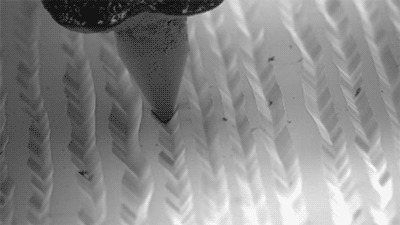General Relativity In 8 Gifs








General Relativity in 8 gifs
More Posts from Fillthevoid-with-space and Others
Merging Galaxies Have Enshrouded Black Holes
NASA - NuStar Mission patch. May 9, 2017 Black holes get a bad rap in popular culture for swallowing everything in their environments. In reality, stars, gas and dust can orbit black holes for long periods of time, until a major disruption pushes the material in. A merger of two galaxies is one such disruption. As the galaxies combine and their central black holes approach each other, gas and dust in the vicinity are pushed onto their respective black holes. An enormous amount of high-energy radiation is released as material spirals rapidly toward the hungry black hole, which becomes what astronomers call an active galactic nucleus (AGN). A study using NASA’s NuSTAR telescope shows that in the late stages of galaxy mergers, so much gas and dust falls toward a black hole that the extremely bright AGN is enshrouded. The combined effect of the gravity of the two galaxies slows the rotational speeds of gas and dust that would otherwise be orbiting freely. This loss of energy makes the material fall onto the black hole.
Image above: This illustration compares growing supermassive black holes in two different kinds of galaxies. A growing supermassive black hole in a normal galaxy would have a donut-shaped structure of gas and dust around it (left). In a merging galaxy, a sphere of material obscures the black hole (right). Image Credits: National Astronomical Observatory of Japan. “The further along the merger is, the more enshrouded the AGN will be,” said Claudio Ricci, lead author of the study published in the Monthly Notices Royal Astronomical Society. “Galaxies that are far along in the merging process are completely covered in a cocoon of gas and dust.” Ricci and colleagues observed the penetrating high-energy X-ray emission from 52 galaxies. About half of them were in the later stages of merging. Because NuSTAR is very sensitive to detecting the highest-energy X-rays, it was critical in establishing how much light escapes the sphere of gas and dust covering an AGN. The study was published in the Monthly Notices of the Royal Astronomical Society. Researchers compared NuSTAR observations of the galaxies with data from NASA’s Swift and Chandra and ESA’s XMM-Newton observatories, which look at lower energy components of the X-ray spectrum. If high-energy X-rays are detected from a galaxy, but low-energy X-rays are not, that is a sign that an AGN is heavily obscured.
NASA’s NuSTAR telescope. Image Credit: NASA
The study helps confirm the longstanding idea that an AGN’s black hole does most of its eating while enshrouded during the late stages of a merger. “A supermassive black hole grows rapidly during these mergers,” Ricci said. “The results further our understanding of the mysterious origins of the relationship between a black hole and its host galaxy.” NuSTAR is a Small Explorer mission led by Caltech and managed by NASA’s Jet Propulsion Laboratory for NASA’s Science Mission Directorate in Washington. NuSTAR was developed in partnership with the Danish Technical University and the Italian Space Agency (ASI). The spacecraft was built by Orbital Sciences Corp., Dulles, Virginia. NuSTAR’s mission operations center is at UC Berkeley, and the official data archive is at NASA’s High Energy Astrophysics Science Archive Research Center. ASI provides the mission’s ground station and a mirror archive. JPL is managed by Caltech for NASA. Related link: Monthly Notices of the Royal Astronomical Society: https://academic.oup.com/mnras/article/468/2/1273/2939810/Growing-supermassive-black-holes-in-the-late For more information on NuSTAR, visit: http://www.nasa.gov/nustar http://www.nustar.caltech.edu Images (mentioned), Text, Credits: NASA/Tony Greicius/JPL/Elizabeth Landau. Greetings, Orbiter.ch Full article

Observing stars is all well and good, but how can I use stars to make my life easier? With a few handy tools and a lot of complicated math and careful table scouting, of course! Okay, it’s not actually any easier to tell where you are, predict when the Sun will rise or where the star Rigel will be at 11:36pm EST, or guess when the next eclipse will be using these tools, but if you don’t have a computer handy maybe it will help.
I did my best to describe all these odd devices in the clearest terms I could but you can hit me up with questions if you have them! Definitely check out some of the video links if you can’t quite picture what I said. I’m also on Twitter at @HDandtheVoid if you’d rather ask me there. And please check out the podcast on iTunes, rate it or review it if you’d like, and subscribe! I’ll always post all the extras here on Tumblr but iTunes is probably more convenient for downloading.
Below the cut are my sources, music credits, vocab list, and the transcript. I mention a play and a story/book and quote an astronomy book in this episode so if you want to see that written down, those sources are there as well. Let me know what you think of this episode, let me know what you think I should research next*, tell me a fun space fact… anything’s helpful!
*(My thoughts were planets, spectroscopy, or Edmond Halley. Let me know by the 6th and I’ll have the next podcast up by July 17th!)
Glossary:
armillary sphere - a device showing the apparent daily motion of the Sun depending on the season, the date, and the latitude of observation. See example video in the link.
Antikythera Mechanism - a device used to establish a calendar based on the Metonic Cycle; eclipse prediction; the location of planets, the Sun, and the Moon on a particular day; and determine the phase of the Moon on a particular day. See example video in the link.
astrolabe - a device for measuring the altitudes of certain celestial objects and for calculating latitude before the development of the sextant. One side is indented, the space called the mater, and can hold a plate depicting the local latitude. Over this plate is a rete, which points out different fixed stars as well as the Sun’s ecliptic, divided into 30 degree sections representing the zodiac signs. On top of the rete was a clock-like hand that stretched the diameter of the astrolabe, called the rule. The rule and rete could be rotated over the face of the plate. See example in the link.
azimuth - a section of the horizon measured between a fixed point and the vertical circle passing through the center of an object. See example in the link.
declination - the angle of the Sun relative to the equator. The Sun’s angle changes with the seasons.
ecliptic - the path of the Sun over the course of a year.
exeligmos cycle - a cycle that is 3 times the saros cycle, or 669 months. It is more accurate means of predicting eclipses and additionally predicts eclipses that will be visible from a location close to the initial eclipse.
kamal - an Arabic navigation tool consisting of a knotted string and a piece of wood. A navigator would tie a knot in the string and, by holding it in their teeth, sight the North Star along the top of the wooden piece and the horizon along the bottom. To return home, the navigator would sail north or south to bring Polaris to the altitude they had observed in their home port, then turn left or right and sail down the latitude, keeping Polaris at a constant angle. Over time, Arab navigators started tying knots at regular intervals of a fingerwidth, called an issbah, that’s about 1 degree and 36 minutes.
metonic cycle - a 19-year cycle developed by the Babylonians to sync their lunar months with the solar year. In the Metonic cycle, there would be 12 years that lasted 12 lunar months and 7 years that lasted 13 months.
saros cycle - a cycle of 223 months that is used to predict eclipses.
sextant - a device used to determine an observer’s location based on the observation of a known celestial object and a lot of calculation. It is still in use by sailors.
stereographic projection - a process for depicting a spherical, 3-dimensional object on a flat surface. An imaginary line is drawn from one point on the object to a point on the flat surface, following an angle to achieve the same relationship between each point on the object. See example in the link
Script/Transcript
Sources:
Video of how to use an armillary sphere
History of the armillary sphere via University of Cambridge
Video lecture on using an armillary sphere. It sounds like he’s trying to sell it.
Video of how to use an astrolabe
Make your own astrolabe suggestions via In the Sky.org
An old guy kept up a website on astrolabes but he died in April 2016, it’s very sad. Excellent info though.
Explanation of unequal hours
Pullman Car Hiawatha summary, just to prove it’s a real play
Chaucer’s Canterbury Tales with its brief astrolabe mention
Video on how to use a sextant
The many uses of a sextant via Classic Sailing
Why a sextant works via Trailnotes
The history of the sextant
The definition of azimuth
The definition of declination
Video of Antikythera Mechanism’s virtual model based on a theoretical and mechanical model. Just a theoretical model!
Antikythera Mechanism via Smithsonian Magazine
The Antikythera Mechanism Research Project website
Antikythera Mechanism via The New Yorker
Saros cycle via NASA
Saros and Exeligmos cycles
Crouper, Heather and Nigel Henbest. The History of Astronomy. Firefly Books: Buffalo, NY, 2007.
“The circular gear wheels of the Antikythera Mechanism reflect the ancient Greeks’ preoccupation with circles—and with the idea that everything in the sky moves around in circular paths, because the heavens are the home of perfection, and a circle is the ideal shape.” (59)
Intro Music: ‘Better Times Will Come’ by No Luck Club off their album Prosperity
Filler Music: ‘Brooklyn Nights Guitar’ loop from Garageband
Outro Music: ‘Fields of Russia’ by Mutefish off their album On Draught
I still highly recommend this good, beautiful web comic about love in space, and now it's all done! You can read it all.




The final three chapters are up. Read it now.
That’s it folks, On A Sunbeam is over. Though I am pondering a sequel.
Thank you all so much for following along.
SpaceX SES-10 Mission successfully Launch
SpaceX - Falcon 9 / SES-10 Mission patch. March 31, 2017
Falcon 9 carrying SES-10 satellite launch
SpaceX took a step into the future Thursday as it reused – for the first time – a recovered first stage of a previously-flown Falcon 9 rocket. Thursday’s mission, carrying the SES-10 communications satellite, lifted off from Pad 39A at Florida’s Kennedy Space Center Thursday 30 March at 18:27 local time (22:27 UTC) and once again landed the booster.
Falcon 9 launch of SES-10
Thursday’s mission made use Falcon 9 the second orbit-capable rocket – after the Space Shuttle – to achieve partial reusability. The Falcon 9 flew from Launch Complex 39A at the Kennedy Space Center, the same pad from which the Shuttle began eighty-two of its missions, including its first and final flights. Reusability has long been a key objective for SpaceX. Making the company’s first launch in March 2006, the small Falcon 1 vehicle carried a parachute system intended to bring its spent first stage back to Earth.
Falcon 9 first stage landed on drone barge
SpaceX’s Falcon 9 rocket deliver SES-10, a commercial communications satellite for SES, to a Geostationary Transfer Orbit (GTO). SES is a world-leading satellite operator, providing reliable and secure satellite communications solutions across the globe.
SES-10 satellite
The SES-10 mission mark a historic milestone on the road to full and rapid reusability as the world’s first reflight of an orbital class rocket. Falcon 9’s first stage for the SES-10 mission previously supported the successful CRS-8 mission in April 2016. For more information about SpaceX, visit: http://www.spacex.com/ Images, Video, Text, Credits: SpaceX/SES. Greetings, Orbiter.ch Full article
Space Station Crew Members Walk In Space to Connect Docking Adapter Component
Outside the International Space Station, Expedition 50 Commander Shane Kimbrough and Flight Engineer Peggy Whitson of NASA conducted a spacewalk March 30 to connect the newly relocated Pressurized Mating Adapter-3 (PMA-3) to the Harmony module in preparation for the delivery of an International Docking Adapter to PMA-3 to which U.S. commercial crew spacecraft will link up to in the years ahead. The mating adapter was robotically relocated from the port side of the Tranquility module to Harmony March 26 by ground controllers. Kimbrough and Whitson also installed the second of two upgraded computer relay boxes on the station’s truss and installed shields and covers over PMA-3 and the vacant port on Tranquility to which the PMA had been attached. It was the 199th spacewalk in support of space station assembly and maintenance, the sixth in Kimbrough’s career and the eighth for Whitson, who surpassed NASA’s Suni Williams for most spacewalks and most aggregate spacewalking time by a female.

Aboard the International Space Station, astronaut Thomas Pesquet of the European Space Agency snapped this photo and wrote, ‘The view at night recently has been simply magnificent: few clouds, intense #aurora. I can’t look away from the windows.'
The dancing lights of the aurora provide stunning views, but also capture the imagination of scientists who study incoming energy and particles from the sun. Aurora are one effect of such energetic particles, which can speed out from the sun both in a steady stream called the solar wind and due to giant eruptions known as coronal mass ejections or CMEs. Credit: NASA/ESA
Make sure to follow us on Tumblr for your regular dose of space: http://nasa.tumblr.com

Inner corona and prominences during Monday’s total solar eclipse
via reddit
Will NASA send astronauts to the moon again or any other planet within the next ten years?

@nasaorion spacecraft will launch on the Space Launch system (the largest spacecraft every built, even bigger than the Saturn V rocket!). Both are under construction @nasa currently, and this is the spacecraft that will take us beyond the low earth orbit of the International Space Station, whether that be the Moon, Mars, or beyond. We will conduct test missions with astronauts on Orion in the early 2020s, and a first mission will take us 40,000 miles beyond the Moon!
What is so special about the solar eclipse to you??
Huh, that’s a very good question and I probably answer it differently each time I get asked it. I love the fact that in totality you can see the solar atmosphere and get a chance to see the magnetic field structure of the Sun. This is something that you can’t normally do. I also love the idea that we’re going to be able to test a bunch of ionospheric models with the help of citizen scientist! This again is a very unique opportunity! But probably the thing that seems so special about this particular eclipse is seeing how excited everyone is about it! Most days I sit in my office working on my science (which I think is the best science and most interesting thing in the world- but I’m probably biased about that) and not too many other people in the world are all that excited about it. But with the eclipse, I get to share how cool this science is, and it’s amazing to see everyone get involved!
-
 illusionremember reblogged this · 1 week ago
illusionremember reblogged this · 1 week ago -
 garnet-t liked this · 1 week ago
garnet-t liked this · 1 week ago -
 ultrameganicolaokay liked this · 7 months ago
ultrameganicolaokay liked this · 7 months ago -
 odinspattern reblogged this · 1 year ago
odinspattern reblogged this · 1 year ago -
 squidsmut liked this · 1 year ago
squidsmut liked this · 1 year ago -
 odinspattern liked this · 1 year ago
odinspattern liked this · 1 year ago -
 billiebeesknees reblogged this · 1 year ago
billiebeesknees reblogged this · 1 year ago -
 billiebeesknees liked this · 1 year ago
billiebeesknees liked this · 1 year ago -
 bowlcutprotag liked this · 1 year ago
bowlcutprotag liked this · 1 year ago -
 denimbex1986 reblogged this · 1 year ago
denimbex1986 reblogged this · 1 year ago -
 gallifreyshawkeye reblogged this · 1 year ago
gallifreyshawkeye reblogged this · 1 year ago -
 icytrickster17 reblogged this · 1 year ago
icytrickster17 reblogged this · 1 year ago -
 icytrickster17 liked this · 1 year ago
icytrickster17 liked this · 1 year ago -
 lillis939 liked this · 1 year ago
lillis939 liked this · 1 year ago -
 tsuntsunfangirl reblogged this · 1 year ago
tsuntsunfangirl reblogged this · 1 year ago -
 septimaseverina reblogged this · 1 year ago
septimaseverina reblogged this · 1 year ago -
 4711-0815-00 liked this · 1 year ago
4711-0815-00 liked this · 1 year ago -
 halfdeadwallfly reblogged this · 1 year ago
halfdeadwallfly reblogged this · 1 year ago -
 halfdeadwallfly liked this · 1 year ago
halfdeadwallfly liked this · 1 year ago -
 biromanticboba reblogged this · 1 year ago
biromanticboba reblogged this · 1 year ago -
 biromanticboba liked this · 1 year ago
biromanticboba liked this · 1 year ago -
 thankyoufortheadventure liked this · 1 year ago
thankyoufortheadventure liked this · 1 year ago -
 downydatura reblogged this · 2 years ago
downydatura reblogged this · 2 years ago -
 downydatura liked this · 2 years ago
downydatura liked this · 2 years ago -
 girlgeekjf-blog liked this · 2 years ago
girlgeekjf-blog liked this · 2 years ago -
 gallifreywhere reblogged this · 2 years ago
gallifreywhere reblogged this · 2 years ago -
 sempiternal-peculiarity liked this · 2 years ago
sempiternal-peculiarity liked this · 2 years ago -
 sacha-da-1 reblogged this · 2 years ago
sacha-da-1 reblogged this · 2 years ago -
 sacha-da-1 liked this · 2 years ago
sacha-da-1 liked this · 2 years ago -
 gallifreyanflower reblogged this · 2 years ago
gallifreyanflower reblogged this · 2 years ago -
 marastarfar reblogged this · 2 years ago
marastarfar reblogged this · 2 years ago -
 toonirl liked this · 3 years ago
toonirl liked this · 3 years ago -
 the-ocean-night reblogged this · 3 years ago
the-ocean-night reblogged this · 3 years ago -
 freetobeafcknriot liked this · 3 years ago
freetobeafcknriot liked this · 3 years ago -
 nalivaa reblogged this · 3 years ago
nalivaa reblogged this · 3 years ago -
 gggtzhdjkjvggjkk liked this · 4 years ago
gggtzhdjkjvggjkk liked this · 4 years ago -
 hattsravenandwritingdesk reblogged this · 4 years ago
hattsravenandwritingdesk reblogged this · 4 years ago -
 50cyg liked this · 4 years ago
50cyg liked this · 4 years ago -
 ttgodhead reblogged this · 4 years ago
ttgodhead reblogged this · 4 years ago -
 nebulacoll liked this · 4 years ago
nebulacoll liked this · 4 years ago -
 sweetlike-silence liked this · 4 years ago
sweetlike-silence liked this · 4 years ago -
 asticot liked this · 4 years ago
asticot liked this · 4 years ago
A podcast project to fill the space in my heart and my time that used to be filled with academic research. In 2018, that space gets filled with... MORE SPACE! Cheerfully researched, painstakingly edited, informal as hell, definitely worth everyone's time.
243 posts
